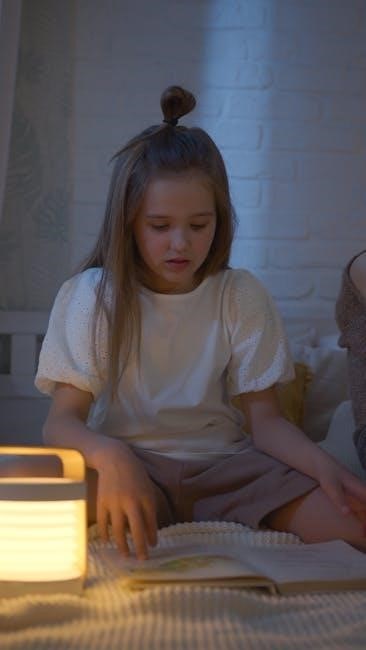“Hey Little Ant” by Phillip Hoose is a touching story that sparks empathy through a conversation between a child and an ant. It teaches respect and compassion, encouraging young readers to reflect on their actions and the impact on all living beings.
Overview of the Book
“Hey Little Ant” by Phillip Hoose is a heartwarming and thought-provoking children’s book that explores themes of empathy, tolerance, and moral dilemmas through a unique dialogue between a child and an ant. The story begins with a child threatening to squish an ant, leading to a poignant plea from the ant to spare its life. This exchange sparks a deeper reflection on the importance of respecting all living beings, no matter how small. The book serves as a powerful educational tool, encouraging young readers to consider the consequences of their actions and fostering compassion. Its simple yet impactful narrative makes it an excellent resource for teaching children about empathy and responsibility toward others.
Importance of the Book’s Theme
The theme of “Hey Little Ant” emphasizes the value of empathy and respect for all life forms. By highlighting the ant’s plea, the book teaches children to consider the consequences of their actions and fosters compassion. This narrative encourages young readers to reflect on the importance of kindness and understanding, even towards creatures often overlooked. The story’s moral dilemma—whether to harm the ant—serves as a catalyst for discussions about responsibility and the interconnectedness of all living beings. The book’s theme is universally relevant, making it a vital tool for educators and parents aiming to instill ethical values in children. Its message promotes a culture of respect and empathy, essential for developing caring and thoughtful individuals.
Target Audience
“Hey Little Ant” is primarily aimed at young children, particularly those in early elementary grades. The simple yet profound dialogue makes it accessible to readers aged 4–8, while its themes resonate with parents and educators seeking to teach empathy and respect. The book serves as a valuable resource for classroom discussions, encouraging children to reflect on their actions and the impact they have on others. Its universal message also appeals to anyone interested in fostering compassion and understanding in young minds. By focusing on a relatable scenario, the story effectively engages its audience, making it a popular choice for both home and educational settings.
Themes Explored in “Hey Little Ant”
Empathy, tolerance, and moral dilemmas are central to the story, encouraging readers to reflect on the consequences of their actions and the importance of respecting all life forms.
Empathy and Understanding
“Hey Little Ant” fosters empathy by presenting a heartfelt dialogue between a child and an ant. The ant’s plea to be spared, emphasizing its role in carrying food home, humanizes its struggle. This exchange encourages readers to consider the ant’s perspective, highlighting the importance of understanding and compassion. The story challenges children to reflect on their actions and their impact on even the smallest creatures. By giving the ant a voice, the book creates a relatable scenario that helps young readers develop a sense of empathy. This emotional connection is a powerful tool for teaching children to value and respect all forms of life, no matter how small or seemingly insignificant they may appear.
Tolerance and Respect
“Hey Little Ant” emphasizes the importance of tolerance and respect for all beings, regardless of their size or role in the world. The story encourages children to consider the perspectives of creatures they might otherwise overlook or harm. By giving the ant a voice, the book teaches young readers to respect life in all forms. The child’s initial indifference to the ant’s fate gradually shifts to understanding and compassion, illustrating the value of tolerance. This narrative helps children develop a sense of responsibility toward other living beings, fostering a culture of respect and kindness. The book serves as a powerful reminder that everyone, no matter how small, deserves to be treated with dignity and care.
Moral Dilemmas
“Hey Little Ant” presents a compelling moral dilemma through the child’s decision of whether to spare the ant’s life. The story explores the ethical implications of harming others, even if they seem insignificant. The child initially views the ant as insignificant, but the ant’s plea challenges this perspective, prompting the child to reconsider their actions. This internal conflict highlights the complexity of moral choices and encourages readers to reflect on their own actions and their impact on others. The book leaves the outcome open-ended, allowing readers to ponder the consequences of their decisions and fostering critical thinking about right and wrong. This approach makes it an effective tool for teaching moral reasoning and empathy.

Author and Illustrator Background
Phillip Hoose, an award-winning author, collaborates with his daughter Hannah Hoose, who illustrates the book. Their teamwork brings depth and charm to the story, making it memorable and impactful.
Phillip Hoose Biography
Phillip Hoose is a celebrated American author known for his thought-provoking children’s books. Born with a passion for storytelling, he has crafted narratives that inspire empathy and understanding. In “Hey Little Ant”, Hoose collaborates with his daughter, Hannah, blending humor and moral dilemmas. His work often highlights the importance of respecting all beings, a theme praised by figures like Jane Goodall. Through his writing, Hoose aims to foster compassion and critical thinking in young readers, making him a respected name in children’s literature. His ability to address complex issues through relatable characters has earned him numerous accolades, solidifying his legacy as an educator and storyteller.
Hannah Hoose’s Role in the Book
Hannah Hoose, Phillip’s daughter, played a significant role in the creation of “Hey Little Ant”. Her contributions included editing and refining the dialogue to ensure it resonated with young readers. Hannah’s insights helped shape the ant’s voice, making it relatable and impactful. Her collaboration brought a fresh perspective to the story, enhancing its emotional depth. Together with her father, she ensured the book’s message of empathy and respect was clear and engaging. Hannah’s involvement not only strengthened the narrative but also highlighted the importance of intergenerational collaboration in storytelling. Her work on the book has been praised for its ability to connect with children and inspire compassionate thinking.

Plot Summary
“Hey Little Ant” revolves around a child threatening an ant with a shoe, sparking a heartfelt dialogue. The ant pleads for mercy, explaining its role, while the child debates the ant’s worth. The story ends without resolution, leaving readers to ponder the moral implications and the importance of empathy.
Dialogue Between the Child and the Ant
The dialogue in “Hey Little Ant” is a poignant exchange where a child threatens an ant with a shoe, saying, “See my shoe, can you see that? Well, now it’s gonna squish you flat!” The ant responds with a heartfelt plea, “Please, oh, please, do not hurt me. I’m on my way home with a crumb of pie. Please don’t hurt me, don’t make me die;” This conversation sparks a moral dilemma, as the child questions whether ants feel pain, while the ant emphasizes its importance and the consequences of its death. The dialogue is simple yet powerful, encouraging readers to reflect on empathy, respect, and the value of all living beings. It leaves a lasting impression on young readers, making them think critically about their actions.
The Child’s Perspective
The child in “Hey Little Ant” initially views the ant with indifference, even amusement, as they consider squishing it. The child’s perspective is one of curiosity and power, as they question whether the ant can see or feel. The child’s words, “See my shoe, can you see that? Well, now it’s gonna squish you flat!” reflect a lack of empathy, as they believe ants don’t feel pain. This perspective highlights the child’s limited understanding of the ant’s life and value. The child’s actions and thoughts challenge the ant to convince them otherwise, creating a moral dilemma. The story leaves the child’s ultimate decision uncertain, encouraging readers to ponder the consequences of their choices. This perspective emphasizes the need for empathy and understanding in resolving conflicts.
The Ant’s Plea
In “Hey Little Ant”, the ant’s plea is both heartfelt and persuasive. The ant begs the child to spare its life, explaining, “I’m on my way home with a crumb of pie. Please don’t hurt me, don’t make me die.” This emotional appeal highlights the ant’s determination to provide for its family and its desire to live. The ant’s words challenge the child’s assumption that ants don’t feel pain, creating a moral dilemma. The ant’s plea not only seeks mercy but also humanizes its existence, encouraging the child—and readers—to consider the value of all lives, no matter how small. This poignant exchange underscores the book’s themes of empathy and understanding. The ant’s voice serves as a powerful reminder of the importance of compassion.

Teaching Notes and Lesson Plans
Teaching notes for “Hey Little Ant” include introducing the book, making predictions, and reading aloud. Activities involve retelling the story, writing from the ant’s perspective, and discussing moral dilemmas. The book’s themes of empathy and respect are ideal for classroom discussions, fostering critical thinking and compassion in students. PDF resources provide additional lesson ideas and discussion questions to engage young learners and encourage meaningful reflection.
Introducing the Book to Students
Introduce “Hey Little Ant” by asking students if they’ve ever seen an ant or considered its perspective. Share the book’s cover and title, sparking curiosity. Discuss the authors, Phillip and Hannah Hoose, and explain the story’s focus on empathy and moral dilemmas. Encourage students to predict the story’s outcome and reflect on their own experiences with insects. Read the book aloud, pausing to discuss key moments, such as the ant’s plea and the child’s decision. Use the provided PDF teaching notes to guide the introduction, ensuring students understand the book’s themes. This approach fosters engagement and sets the stage for meaningful discussions about respect and compassion.
Discussion Questions
Engage students with thought-provoking questions like, “What do you think the child should do—squish the ant or let it go?” and “Why do you think the ant is carrying a crumb?” Discuss the moral dilemma the child faces, encouraging students to share their opinions. Ask, “Have you ever seen someone hurt an ant? How did you feel?” to connect the story to their experiences. Explore the themes of empathy and respect by questioning, “Why is it important to consider the feelings of small creatures?” and “What message do you think the authors want us to learn?” These questions foster critical thinking and deepen understanding of the book’s themes.
Activities for Students
Engage students with hands-on activities to reinforce the book’s themes. Assign a writing task where students imagine they are the ant, writing a diary entry about their encounter with the child. Create a class poster titled “Why We Should Respect Small Creatures,” with illustrations and reasons inspired by the story. Role-play the dialogue between the child and the ant, encouraging students to express their perspectives. Ask students to draw and describe what they think happens after the story ends, promoting creative thinking about the child’s decision. These activities help students connect emotionally with the story and its message, fostering empathy and understanding.

Where to Find “Hey Little Ant” in PDF
The PDF version of “Hey Little Ant” is available for download on various online platforms. Visit the Internet Archive or educational websites offering free e-books for students and educators.
Download Options
The PDF version of “Hey Little Ant” can be downloaded from various online platforms. The Internet Archive offers a free download option, while educational websites provide direct links. Users can access the book through platforms like pdfftvo.web.app or Issuu. The file size is approximately 26 MB, ensuring easy download. Additionally, some platforms allow viewing the book as a flipbook, making it accessible on devices like iPhones and iPads. Always verify the source to ensure a safe and complete download. This convenient access makes it easy for students and educators to utilize the book for learning purposes.
Online Platforms
“Hey Little Ant” is accessible on various online platforms, making it convenient for readers to find and download. The Internet Archive provides a direct link to the PDF version, while educational websites like Issuu and pdfftvo.web.app offer easy access; These platforms ensure that the book is readily available for students, educators, and general readers. Additionally, some platforms feature flipbook versions, enhancing readability on mobile devices. Users can search for the book using specific keywords or hashtags to locate it quickly. These online resources make it simple to access “Hey Little Ant” for both personal reading and classroom use, promoting its universal message of empathy and respect.
Availability
“Hey Little Ant” is widely available in PDF format, ensuring easy access for readers worldwide. The book can be downloaded from platforms like the Internet Archive and educational websites such as pdfftvo.web.app. Additionally, it is featured on platforms like Issuu, where users can view or download it for free. The PDF version is also shared on various online repositories, making it simple to locate and access. Its availability in digital formats has made it a convenient resource for classrooms, personal reading, and library collections. This accessibility ensures that the book’s message of empathy and respect reaches a broad audience, aligning with its educational goals and universal appeal.

Importance of Respecting Other Beings
Respecting other beings is a vital lesson in “Hey Little Ant”, teaching children to value all life forms. This fosters compassion, responsibility, and understanding, encouraging kindness toward even the smallest creatures.
Teaching Respect Through Stories
“Hey Little Ant” uses a simple yet powerful narrative to teach respect for all beings. By illustrating the ant’s plea, the story helps children understand the value of empathy and kindness. This approach makes complex moral lessons accessible to young minds, fostering a deeper appreciation for life in all forms. The book serves as a tool for educators and parents to initiate conversations about compassion and responsibility. Through its relatable characters and heartfelt dialogue, it encourages children to reflect on their actions and their impact on others, promoting a culture of respect and understanding from an early age.
Impact on Young Readers
“Hey Little Ant” leaves a lasting impression on young readers by encouraging empathy and self-reflection. The story’s open-ended conclusion prompts children to consider the consequences of their actions, fostering a deeper understanding of kindness and responsibility; Through its simple yet profound dialogue, the book helps children develop compassion for all living beings, no matter how small. This engagement with moral dilemmas at an early age cultivates critical thinking and a sense of shared responsibility for the world around them. The book’s ability to spark meaningful conversations makes it a powerful tool for shaping young minds and nurturing a generation that values empathy and respect.

Cultural and Historical Context
“Hey Little Ant” resonates across cultures by promoting universal values of empathy and respect. Its timeless message aligns with educational goals globally, inspiring kindness and environmental awareness in young minds.
Relevance in Modern Education
“Hey Little Ant” remains highly relevant in modern education, addressing themes of empathy, respect, and moral decision-making; Its engaging dialogue encourages critical thinking and emotional intelligence, aligning with current educational goals focused on social-emotional learning. The book’s universal message about kindness and understanding resonates with diverse student populations, making it a valuable tool for fostering inclusive classrooms. Educators often use it to teach compassion and tolerance, while its availability in PDF format supports digital learning environments. By exploring perspectives, it helps students develop essential life skills, ensuring its continued importance in contemporary educational settings.
Universal Message
“Hey Little Ant” delivers a timeless and universal message about empathy, kindness, and the importance of respecting all living beings. Through its simple yet powerful dialogue, the book encourages readers to consider the consequences of their actions and to treat others with compassion. Its themes of understanding and coexistence transcend age and culture, making it a story that resonates with readers worldwide. By highlighting the value of even the smallest creatures, the book fosters a sense of responsibility and shared humanity. This universal appeal ensures its relevance across diverse audiences, inspiring reflection and kindness toward all forms of life.
Reviews and Ratings
“Hey Little Ant” has received widespread acclaim for its heartfelt message, earning a Silver Medal at the Moonbeam Children’s Book Awards. Readers praise its ability to inspire compassion and empathy in young minds, making it a cherished choice for parents and educators alike.
Reader Feedback
Readers have enthusiastically praised “Hey Little Ant” for its engaging dialogue and meaningful message. Parents and educators highlight its ability to inspire compassion and empathy in children. Many appreciate how the story encourages young readers to reflect on their actions and their impact on even the smallest creatures. The book has been described as a valuable tool for sparking discussions about respect and kindness. Its relatable characters and thought-provoking themes make it a favorite among both children and adults. The ant’s plea and the child’s dilemma resonate deeply, leaving a lasting impression on readers. The simplicity of the story, combined with its profound message, has made it a cherished choice for families and classrooms alike.
Critical Acclaim
“Hey Little Ant” has received widespread critical acclaim for its thought-provoking narrative and universal message. Renowned figures like Jane Goodall have praised the book for its ability to inspire compassion and empathy in young readers. The story’s simple yet impactful dialogue has been highlighted as a powerful tool for teaching children about respect and kindness. Educators and reviewers alike have commended the book for its ability to spark meaningful discussions and encourage critical thinking. The ant’s plea and the child’s dilemma resonate deeply, making it a standout title in children’s literature. The book’s timeless themes and engaging format have solidified its place as a beloved and educational resource for families and classrooms worldwide.
“Hey Little Ant” is a heartwarming and educational tale that teaches empathy, respect, and kindness. Its timeless message resonates with readers of all ages, making it a cherished read.
Final Thoughts on the Book
“Hey Little Ant” is a charming and thought-provoking story that engages young readers with its simple yet meaningful dialogue. The book’s exploration of empathy, tolerance, and moral dilemmas makes it a valuable tool for teaching compassion. Its ability to spark discussions about respecting all living beings, no matter how small, is unparalleled. The child’s decision to spare the ant leaves a lasting impression, encouraging readers to reflect on their own actions. With its colorful illustrations and relatable characters, this book is perfect for early readers or classroom discussions. Available as a free PDF, it remains a popular choice for parents and educators seeking to instill kindness and understanding in children. Its timeless message ensures it will continue to resonate with audiences for years to come.
Encouragement to Read
“Hey Little Ant” is a must-read for children and educators alike, offering a gentle yet powerful lesson on empathy and compassion. Its engaging dialogue and relatable characters make it an excellent tool for fostering discussions about tolerance and respect. The book’s availability as a free PDF ensures accessibility for everyone. By exploring the moral dilemmas faced by both the child and the ant, readers are encouraged to reflect on their own actions and the impact they have on others. This charming story not only entertains but also inspires young minds to embrace kindness and understanding. It’s a timeless tale that will leave a lasting impression, making it a valuable addition to any home or classroom library.
